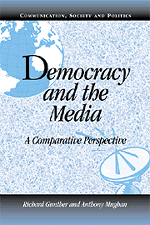Book contents
- Frontmatter
- Contents
- List of Contributors
- Acknowledgments
- 1 The Media in Democratic and Nondemocratic Regimes: A Multilevel Perspective
- 2 The Media and Politics in Spain: From Dictatorship to Democracy
- 3 Institutional Incapacity, the Attentive Public, and Media Pluralism in Russia
- 4 Democratic Transformation and the Mass Media in Hungary: From Stalinism to Democratic Consolidation
- 5 The Modernization of Communications: The Media in the Transition to Democracy in Chile
- 6 Media Influence in the Italian Transition from a Consensual to a Majoritarian Democracy
- 7 The United States: News in a Free-Market Society
- 8 Japan: News and Politics in a Media-Saturated Democracy
- 9 The Netherlands: Media and Politics between Segmented Pluralism and Market Forces
- 10 Great Britain: The End of News at Ten and the Changing News Environment
- 11 Germany: A Society and a Media System in Transition
- 12 The Political Impact of the Media: A Reassessment
- References
- Index
4 - Democratic Transformation and the Mass Media in Hungary: From Stalinism to Democratic Consolidation
Published online by Cambridge University Press: 05 June 2012
- Frontmatter
- Contents
- List of Contributors
- Acknowledgments
- 1 The Media in Democratic and Nondemocratic Regimes: A Multilevel Perspective
- 2 The Media and Politics in Spain: From Dictatorship to Democracy
- 3 Institutional Incapacity, the Attentive Public, and Media Pluralism in Russia
- 4 Democratic Transformation and the Mass Media in Hungary: From Stalinism to Democratic Consolidation
- 5 The Modernization of Communications: The Media in the Transition to Democracy in Chile
- 6 Media Influence in the Italian Transition from a Consensual to a Majoritarian Democracy
- 7 The United States: News in a Free-Market Society
- 8 Japan: News and Politics in a Media-Saturated Democracy
- 9 The Netherlands: Media and Politics between Segmented Pluralism and Market Forces
- 10 Great Britain: The End of News at Ten and the Changing News Environment
- 11 Germany: A Society and a Media System in Transition
- 12 The Political Impact of the Media: A Reassessment
- References
- Index
Summary
Television images from 1989–90 will haunt many of us for the rest of our lives: German youths in colorful dress dancing and waving flags on top of the Berlin Wall; massive prodemocracy demonstrations in Leipzig, East Germany; Václav Hável announcing the victory of Czechoslovakia's Velvet Revolution at Prague's Wenceslaw Square; Imre Nagy, prime minister during the 1956 Hungarian Revolution, is finally buried with full honors in Budapest. These unforgettable images were seen by over a billion people around the world, including millions of citizens of Central and Eastern Europe. These citizens, who became key players in these events, were motivated by the information and visual images they received from the media daily about the collapse of the status quo in the Soviet-dominated parts of Europe. Undoubtedly, the mass media played important roles both in the breakdown of these Communist regimes in 1989–90 and in the radical transformation of the region since then.
An analysis of the impact of the mass media on the dramatic events of 1989–90 and the subsequent democratization of Central and Eastern Europe requires that we first examine the roles played by the media under the former Communist regimes. Institutions rarely change overnight, and mass media institutions are no exception. Significant parts of anti- and post-Communist media activities during and after 1989–90 occurred within an institutional framework that had been built by Communist one-party regimes several decades earlier.
- Type
- Chapter
- Information
- Democracy and the MediaA Comparative Perspective, pp. 122 - 164Publisher: Cambridge University PressPrint publication year: 2000
- 15
- Cited by



